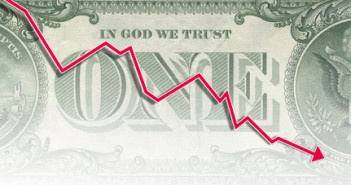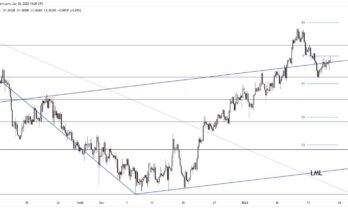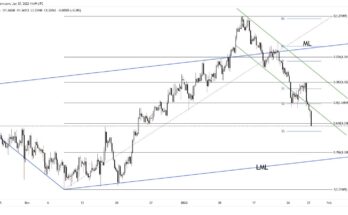Equity markets managed to avoid starting the new trading week in the red, with the S&P recovering from earlier losses on the back of escalating violence in Ukraine, as investors instead focused on positive data points from the American economy.
The headline reading for the ISM Services PMI survey pushed to a 8-month high and beat the median analyst estimate, causing investors to shift gears and add exposure to high-yielding asset classes; the DXY managed to hold its ground in the mid-79s, while USDJPY regained the 102 level, the S&P jolted to a gain of 0.19%, with the yield on the 10-year US treasury edging up to 2.60%.
The overnight Asian session saw traders hone their focus on Australian data releases as Tokyo was off for another holiday.  Australia’s trade balance figures kicked things off showing the value of imported goods over the month of March remained flat for the Australian economy, whereas exports decreased by 2%, giving way to a lower surplus than had been expected by analysts. The official reading on the trade balance highlighted a surplus of only $0.73bn, lower than February’s $1.2bn, which was also the median forecast for the March figure. The Aussie showed little reaction to the slightly weaker trade numbers, with investors content to focus on the interest rate statement from the Reserve Bank of Australia and any communication the central bank might have in its statement regarding the domestic currency.
As expected the RBA decided to leave the cash rate unchanged at 2.5%, also choosing not to amend its language in regards to the Antipodean currency and its lofty level by historical standards. While the Aussie has come off its highs during the month of April as investors ratchet back expectations for an interest rate hike in 2014 due some weaker than expected domestic data, the absence of any additional FX comments from the RBA has caused AUDUSD to pop into the low 0.93s this morning.
Heading over to Europe, the major indices are under pressure before the North American hand-off, with global sentiment still struggling as casualties increase in Ukraine. Despite the ongoing conflict in Eastern Europe, the EUR is on the offensive today, putting in solid gains against the American unit after a slew of positive Service PMI readings were released overnight.  In addition to just the headline numbers themselves, the better news for the Eurozone is that the periphery nations are showing some strong gains, with Spain’s survey increasing from 54.0 to 56.5 – a seven year high.  Along with the improved PMI number, Spain also reported a decline in unemployment that was double what analysts had expected, with unemployment falling by over 100k during the month of April. The increased activity in the service sector for the periphery Euro nations has buoyed the common-currency this morning, pushing EURUSD north of the 1.39 level, increasingly close to 2014’s high of 1.3967.
Getting set for the North American open, the USD is struggling to maintain its composure after the better than expected Eurozone service sector PMIs and a bounce in commodity-linked currencies after the RBA refrained from taking additional steps to try and talk down its currency.  On the economic data front, trade balance numbers for both the the US and Canada were released this morning, with the American trade balance coming in bang on estimates as the deficit narrowed to $40.4bn from the $41.9bn registered in February.
On the Canadian side of the border, the trade balance came in essentially flat, undershooting the small surplus of $0.13bn that analysts had expected. While March’s trade surplus did come in weaker than expected, the silver lining was that surplus in February was revised higher to $0.85bn, after exports increased by a greater amount than originally anticipated. While the revisions to February’s export numbers are an overall positive for the Canadian economy, the real challenge will be to see whether the momentum can be sustained, as the total value of exports still remains well below the highs seen in 2008.
The CAD is higher against its American counterpart this morning, with USDCAD dipping into the low 1.09s as a consequence of broadly weaker USD and the better Canadian export numbers in February. Commodities are drifting before the opening bell, with front-month WTI flat in the mid-$99s/barrel, while Gold edges slightly lower but still remains north of $1,300/ounce. S&P futures are dictating a slightly negative start to the trading day, although the losses are muted thus far and had been pivoting close to unchanged until USDJPY lost the 102 handle.
As we get set for the remainder of the North American session, the Ivey PMI report for the Canadian economy is due to be released at 10:00EST. Purchasing manager activity is expected to continue rolling over, with the seasonally adjusted number forecast to come in at 54.0, down from the 55.2 registered in March.  With employment numbers set to be released on Friday, the employment sub-index will be important to watch, as it has shown contraction in this area for the last three months. While last month’s headline employment report showed a good build in the amount of new jobs created, the majority of these were part-time, so it will be interesting to see if the quality of labour market improvements have improved since March. Also key to watch with the Ivey PMI will be the prices sub-index, which although increasing to a sky-high 72.2 in March, has not yet filtered through to consumer prices. Sluggish consumer demand along with high competition from south of the 49th parallel has kept Canadian companies from raising prices, instead choosing to trim back margins until the economy is on stronger footing and businesses can be confident higher prices won’t scare off already feeble demand.
While today’s Ivey PMI release most likely won’t provide a large market reaction in USDCAD, it will give market participants a chance to gauge how the job market is looking ahead of the official jobs stats later in the week, so make sure to speak with you dealing teams on how to position accordingly for the remainder of the week.
More:Â Draghi grapples with money markets signalling recovery too early



